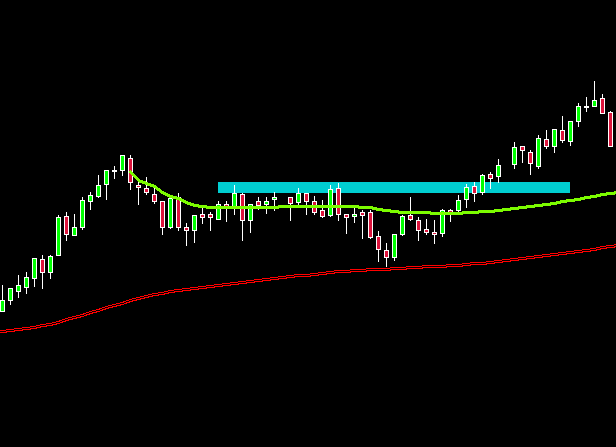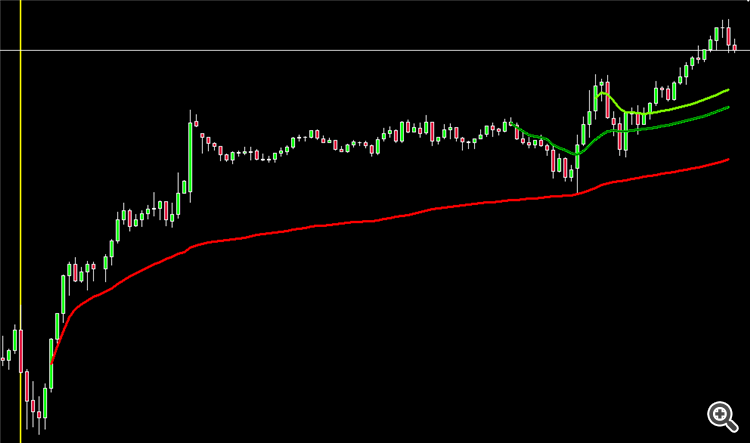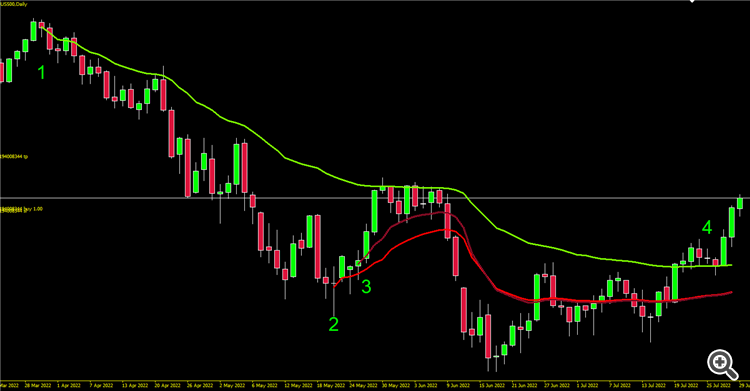Introduction
Are you ready to take your trading game to the next level? Look no further than Anchored Volume Weighted Average Price (AVWAP), the most powerful technical analysis tool available for traders of all levels. Whether you’re an experienced trader or just starting out, AVWAP can help you make more informed trading decisions by providing an objective measurement of supply and demand for a specific security.
In this article, we’ll show you how to use AVWAP effectively and provide real-world examples of how traders have used it to make profitable trades. You’ll learn how AVWAP combines price, volume, and time to give you a better understanding of the emergent sentiment of a security from that moment forward. We’ll also show you how to analyze AVWAP across multiple timeframes and use it as a stop-loss strategy.
The AVWAP has become increasingly popular among traders, especially those engaged in intraday trading. The AVWAP is a modification of the Volume Weighted Average Price (VWAP) indicator that incorporates a price bar or anchor point chosen by the trader. This provides a more objective measurement of supply and demand for a specific security, regardless of your level of experience in trading.
One of the most important advantages of the AVWAP is its ability to combine price, volume, and time to give you a better understanding of the emergent sentiment of a security from that moment forward. Whether you are an experienced trader who prefers to analyze price action over a longer period of time or a new trader focused on short-term trading, the AVWAP is a versatile tool that can be used effectively on any timeframe.
As you use the AVWAP to analyze the trend of a security, you'll want to pay close attention to the direction and slope of the indicator, as well as how far above or below price action is in relation to the AVWAP. This can provide valuable insights into whether a security is overbought or oversold, helping you identify potential trading opportunities.
VWAP vs AVWAP
VWAP is Volume Weighted Average Price
AVWAP is Anchored Volume Weighted Average Price
If you're new to trading, you may have heard about VWAP and AVWAP and wondered what the differences are. Essentially, VWAP is a calculation that provides an average price of a security based on its volume throughout the day. In contrast, AVWAP is a modified version of VWAP that allows traders to anchor the calculation to a specific price bar, giving them a more objective measurement of supply and demand at a specific point in time.
The VWAP is widely used by institutional traders to assess market trends and determine optimal entry and exit points. It is an ongoing calculation that is updated throughout the day, and it serves as a benchmark for institutional traders.
On the other hand, AVWAP gives traders more flexibility and versatility by allowing them to anchor the calculation to any visible price bar. The AVWAP continues from the anchored point to the right side of the chart, making it a powerful tool for traders who want to analyze the market trend from a specific point in time.
While both indicators can be used to identify areas of support and resistance on the chart, the AVWAP can provide a more accurate measure since it considers a specific point in time. Traders can use both VWAP and AVWAP to determine potential entry and exit points, as well as to set stop-loss orders.
AVWAP formula
The formula for Anchored VWAP is as follows:
VWAP = (Sum of (Price x Volume) for the Anchored period) / (Sum of Volume for the anchored period)
To calculate Anchored VWAP, the trader must first determine the time period over which the VWAP will be calculated. This time period is known as the anchored period.
Next, the trader must identify the anchor point, which is the specific time in the past that will serve as the reference point for the VWAP calculation.
The trader then calculates the total volume and total value of all trades that have occurred within the anchored period, starting from the anchor point.
Finally, the trader divides the total value by the total volume to arrive at the anchored VWAP. Anchored VWAP can be applied to various trading instruments, such as stocks, exchange-traded funds (ETFs), futures contracts, and options.
It is typically used on securities with high liquidity and volume, as these securities tend to have more reliable VWAP readings. However, it may not be suitable for symbols that do not have volume, such as an index or some forex pairs.
Anchored VWAP is best used during periods of high volume and volatility, as it helps to smooth out short-term price fluctuations and provide a clearer picture of the longer-term trend. However, it may not be as useful during periods of low volume and volatility, as the VWAP may not accurately reflect market sentiment.
Approaches
By anchoring the VWAP to a specific point in the past, traders can filter out short-term fluctuations and focus on the longer-term trend. In this way, the Anchored VWAP can be used in conjunction with important events, as well as for timing buy trades.
One of the approaches that traders can use when using Anchored VWAP in conjunction with important events is to anchor the VWAP to the time period surrounding the event.
For example, if the event is scheduled to take place at 2:00 pm, traders can anchor the VWAP to the time period from 1:00 pm to 3:00 pm. By doing this, they can gain a sense of how the security has been trading in the lead-up to the event, which may help them identify potential buying or selling opportunities.
Another approach is to use anchored VWAP as a reference point after the event has taken place. Traders can anchor the VWAP to the time period immediately following the event and use it as a way to assess how the market is reacting to the news. If the security is trading above the anchored VWAP, it may be a sign of bullish sentiment, while if it is trading below the anchored VWAP, it may be a sign of bearish sentiment.
For timing buy trades, one approach that traders can take is to buy near the anchored VWAP. Some traders may look for opportunities to buy a security when it is trading near its anchored VWAP. The idea is that the security may be undervalued if it is trading below the anchored VWAP, and therefore may have potential for price appreciation.
On the other hand, traders can also wait for the security to move above its anchored VWAP and then enter a buy trade. This can be seen as a sign of buying momentum, and may indicate that the security is starting to trend upwards.
Traders can also wait for the security to cross above its anchored VWAP and then enter a buy trade. This can be seen as a bullish signal and may indicate that the security is breaking out of a sideways trading range.
It's important to note that these are just a few examples, and there are many other ways that anchored VWAP can be used in trading.
Traders can also use the direction and slope of the AVWAP to identify the trend of the security. If the AVWAP is sloping upwards, it can indicate that the security is in an uptrend, while a downward sloping AVWAP can indicate a downtrend. Traders can use this information to identify potential entry and exit points in the market.
Moreover, traders can use the distance between the security's price action and the AVWAP to identify potential support and resistance levels. If the price is trading above the AVWAP, it can indicate that there is support for the security at that level, while trading below the AVWAP can indicate resistance.
By using the AVWAP in conjunction with other technical analysis tools, such as trendlines and moving averages, traders can identify key levels in the market and make informed trading decisions.
Another approach is to use the AVWAP on multiple timeframes. The AVWAP can be used on any timeframe and is actually best used on multiple timeframes. By analyzing the AVWAP on different timeframes, traders can get a better understanding of the long-term trend of the security and identify potential trading opportunities. For example, if the AVWAP is sloping upwards on both the daily and weekly timeframe, it may indicate a strong uptrend, indicating that the security is in a longer-term uptrend.
Where to anchor
When it comes to anchoring VWAP, it's important to choose the right events to anchor from. These events should be significant and have the potential to impact the price of the security being traded.
One common anchor is the previous highs and lows in the chosen time frame. Anchoring from the previous swing high or low can provide traders with the average price that traders paid on the run-up, which can act as a support level when the price tries to go below it. Year-to-date, month-to-date, and week-to-date AVWAPs are also important anchors as they act as strong support and resistance levels. They show the average price that traders paid for their positions and traders tend to defend these levels.
Additionally, gap-ups and downs can also serve as great anchors since they represent significant price movements with a high level of market participation.
Earnings reports are another important event that can serve as an anchor for VWAP. Traders can anchor the VWAP from the day after earnings to track users who bought or shorted the stock after earnings. This can sometimes coincide with gap up and downs because they sometimes happen right after earnings.
Other events that traders may consider include economic releases, central bank meetings, political events, and natural disasters. Economic releases, such as GDP, employment figures, and inflation data, can have a major impact on financial markets, providing insight into the health of the economy and influencing central bank policy.
Central bank meetings can also indicate the direction of interest rates and other key economic indicators.
Political events and natural disasters can also disrupt economic activity and lead to price movements in financial markets.
Ultimately, the choice of anchor point will depend on the trader's individual trading strategy and the specific security being traded. By choosing the right anchor points, traders can gain insight into the average price paid by other market participants and use this information to make more informed trading decisions.
Using anchored VWAP as a reference point after the event
Using anchored VWAP as a reference point after an event can provide traders with valuable insight into market sentiment and potential trading opportunities. For example, let's say that a company announces better-than-expected earnings results, causing a surge in its stock price. A trader can anchor the VWAP to the time period immediately following the earnings announcement and use it as a reference point to assess how the market is reacting to the news.
If the stock price is trading above the anchored VWAP, it may indicate that there is bullish sentiment in the market, and the price is likely to continue its upward trend. Conversely, if the stock price is trading below the anchored VWAP, it may indicate that there is bearish sentiment in the market, and the price is likely to continue its downward trend.
Traders can use this information to make informed trading decisions, such as entering a long position if the stock is trading above the anchored VWAP and a short position if it is trading below it. They can also use the anchored VWAP as a reference point to set stop-loss orders or take-profit levels, based on the level of support or resistance provided by the VWAP.
Buying near anchored VWAP
Traders can also employ the anchored VWAP strategy by looking for buying opportunities when a security is trading close to its anchored VWAP. This strategy is based on the assumption that the security might be undervalued if its current price is below the anchored VWAP, which could indicate potential for price appreciation.
For instance, if a trader has anchored the VWAP to the start of the year and the security is trading in proximity to the anchored VWAP, they might consider this a favorable time to buy. By purchasing the security close to the anchored VWAP, traders can potentially benefit from undervaluation and position themselves for future price gains.
Buying when the security moves above anchored VWAP
An alternative method that traders can use with anchored VWAP is to wait for the security to surpass its anchored VWAP and then initiate a buy trade. The underlying idea behind this approach is that when a security is trading above its anchored VWAP, it may signal the start of an upward trend and present an opportunity for buying momentum.
For instance, suppose a trader has anchored the VWAP to the start of the current quarter and the security has recently crossed above the anchored VWAP. In that case, they may consider this a bullish indicator and enter a long position. By purchasing when the security surpasses the anchored VWAP, traders can capitalize on buying momentum and potentially profit from price appreciation.
Buying when the security crosses above the anchored VWAP
To potentially take advantage of a breakout, traders may wait for a security to cross above its anchored VWAP before entering a buy trade. This approach is based on the belief that a security crossing above its anchored VWAP is a bullish signal, indicating a potential breakout from a sideways trading range.
For instance, a trader could anchor the VWAP to an important news release and wait for the security to cross above the anchored VWAP before entering a long position. This way, they could potentially benefit from the breakout and position themselves for potential price appreciation.
When the direction changes
Throughout our analysis of the different anchors used with Anchored Volume Weighted Average Price (AVWAP), we have examined how the price tends to respond to them as either support or resistance levels. However, it is important to keep in mind that these levels are not always absolute and can sometimes fail to hold. Generally, it is often observed that these levels tend to break down when the AVWAP begins to flatten out.
This flattening of the AVWAP can indicate a shift in market sentiment and a potential change in direction of the security's price. As such, traders may want to consider adjusting their trading strategy accordingly, such as by moving stop-loss orders or re-evaluating their position. It is also important to note that while the AVWAP is a useful tool, it is not infallible, and traders should always be vigilant and incorporate a range of technical and fundamental analysis techniques into their trading decisions.
AVWAP as a stoploss
Anchored Volume Weighted Average Price (VWAP) is a versatile technical analysis tool that traders can use in multiple ways, including as a potential stop-loss strategy. Here are five examples of how traders can use anchored VWAP as a stop-loss strategy:
-
Setting a percentage below the anchored VWAP: As mentioned earlier,
traders can set a stop-loss order at a certain percentage below the
anchored VWAP. This can help limit potential losses if the security's
price starts to move against the trader.
-
Using multiple anchored VWAPs: Another approach is to use multiple
anchored VWAPs, each with a different time period, and set stop-loss
orders based on the distance between the current price and the anchored
VWAPs. This can provide a more comprehensive view of the security's
trend and help traders make more informed decisions.
-
Combining with other technical indicators: Traders can also use
anchored VWAP in combination with other technical indicators, such as
Relative Strength Index (RSI), Moving Average Convergence Divergence
(MACD), or Bollinger Bands, to set stop-loss orders. This can help
provide a more nuanced and accurate view of the security's trend and
potential risk.
-
Adjusting the stop-loss based on market volatility: Another approach is
to adjust the stop-loss based on the market's volatility. For instance,
traders can set a wider stop-loss in a more volatile market to avoid
getting stopped out too early or too frequently.
-
Using fundamental analysis: Finally, traders can also use fundamental
analysis to set stop-loss orders. By assessing a company's financial
health, business model, and industry trends, traders can determine the
appropriate level of risk and set stop-loss orders accordingly.
It's important to note that using anchored VWAP as a stop-loss strategy is just one possibility, and there are many other ways that stop-loss orders can be used. It's always a good idea to carefully consider your own investment objectives and risk tolerance before making any trading decisions. Additionally, it's important to keep in mind that stop-loss orders do not guarantee a certain price, and the security may be sold at a price that is different from the stop-loss price if the market moves quickly.
Statistical analysis techniques
Statistical analysis techniques are an essential tool for evaluating the performance of anchored volume weighted average price (VWAP). By incorporating statistical data into an analysis of anchored VWAP, traders can gain a more nuanced understanding of the indicator and how it is performing.
For example, mean reversion analysis is one statistical technique that can be used to analyze anchored VWAP. This involves comparing the security's current price to its anchored VWAP. If the security is trading above its anchored VWAP, it may be a sign that it is overvalued, and mean reversion analysis can assess the likelihood that the security's price will revert back towards the anchored VWAP.
Another statistical analysis technique is to evaluate the security's volatility. High volatility can increase the risk of trading, and the anchored VWAP may be less reliable as a reference point. On the other hand, if the security has low volatility, it may be less risky to trade and the anchored VWAP may be more reliable as a reference point.
Correlation is another approach used to evaluate anchored VWAP. By assessing the correlation between the security's price and its anchored VWAP, traders can determine whether the anchored VWAP is a reliable reference point. A strong correlation indicates that the anchored VWAP is a useful reference point, while a weak correlation suggests that the anchored VWAP is less reliable.
Traders can also use statistical measures such as the standard deviation and coefficient of variation to assess the reliability and stability of anchored VWAP. For instance, calculating the standard deviation of anchored VWAP over a specific time period can measure the dispersion of the data and assess the reliability of the indicator. Similarly, the coefficient of variation is a measure of the relative dispersion of a dataset that can provide a useful perspective on the stability of the indicator.
In addition to these statistical measures, traders can compare anchored VWAP to other indicators or benchmarks to assess its performance and usefulness in a particular trading strategy. For example, comparing anchored VWAP to the simple moving average (SMA) of a security can help traders determine how well the indicator is tracking the underlying trend.
It's essential to use a range of technical and fundamental analysis tools, including statistical analysis techniques, and to carefully consider your own investment objectives and risk tolerance before making any trading decisions. While these are just a few examples of statistical analysis techniques that can be used with anchored VWAP, there are many others that traders can explore. Incorporating statistical data into an analysis of anchored VWAP can provide a more comprehensive view of the indicator and help traders make more informed decisions about how to use it in their trading strategies.
Planning Trades with AVWAP
When utilizing the AVWAP indicator for trade planning, it is recommended to anchor it to significant events, such as the start of the year, day, or relevant highs/lows for your timeframe. The direction and slope of the AVWAP, as well as its distance from price movement, should also be considered.
If you're looking to initiate a buy trade, it is advisable to wait for a dip (pullback) and then buy into strength. To do so, start by determining the trend on a larger timeframe (e.g., uptrend on the daily chart, characterized by higher highs and higher lows). Anchor the AVWAP to the low of the trend's starting point and look for price touches, or handoffs, to determine the new anchor point.
Next, move to a lower timeframe and anchor the AVWAP to the most recent and relevant high and low. This will help identify who is in control of the price action or if the market is in a state of equilibrium. Look for price movement above the AVWAP from the high, while the AVWAP remains flat or rises, as this indicates that buyers are in control and presents a buying opportunity.
For stop placement, refer to the AVWAP from the recent low. When buyers are in control and stop losses are placed below the most recent or relevant lows, a setup is created. By following this approach, you can utilize the AVWAP indicator to help plan and execute trades effectively.
Example Trades
In the chart below of US500 (S&P500), the yellow vertical line represents
the opening of the day at 9:30 am EST. The red AVWAP is anchored to the momentum
bar, shortly after the open. As you can see, the AVWAP was defended during the
day's trading session, indicating that the buyers were in control. If you were
to consider entering on a pullback, you could wait for the AVWAP to be flat to
rising, with the price above it. Then, you could anchor an AVWAP to a recent
swing high and wait for the price to decline, then rise above the AVWAP to enter
the trade. Finally, you could anchor an AVWAP to the low that was just created
to use as a stop, using it as a guide to tell you which higher low is relevant
for stops.
The following chart showcases an example of how the AVWAP can be utilized to identify breakouts. Firstly, anchor the AVWAP to the recent swing high and low to establish a reference point. Observe how the AVWAPs begin to converge and move closer together, indicating an impending price movement. Once the price breaks above the recent highs and remains above the AVWAP, it signifies that buyers have taken charge. This is an opportune moment for traders to consider entering a long position.

Daily Chart Example
The chart below has 3 AVWAPs with numbers at important points.
1 - AVWAP anchored to the top. See how the downtrend pullbacks respect this line, you can use this to enter low risk trades.
2 - In a downtrend, you want to know when to enter for a short. Anchor to a bottom, when price cuts down thru its time to sell as sellers are in control.
3 - You can also anchor from where the momentum began, giving you an early warning where you can use a tighter stop.
4 - Once the down trending AVWAP was cut through upwards, it flattens out and price moves up. Above a flat to rising AVWAP at this point is telling you that buyers are in control.
Where can I get this indicator?
AVWAP can be used on a variety of trading platforms that support technical analysis and charting tools. However, it's important to note that the availability and functionality of AVWAP may vary between platforms. Additionally, as mentioned earlier, AVWAP may not be suitable for all types of trading instruments, such as those that don't have sufficient volume or liquidity. Therefore, it's important for traders to evaluate their trading needs and choose a platform that offers the appropriate tools for their specific trading strategy.
There are several other ways to access Anchored VWAP for MT4 or MT5, depending on your preferences and experience with the platform. Here are some options:








No comments:
Post a Comment
Let's hear what you have to say!